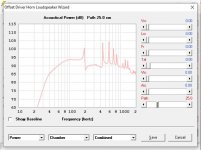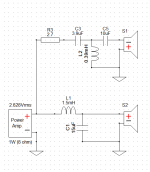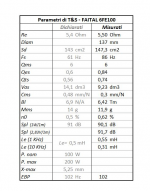Hi there!
A question, why I ended up with a 43Hz tuning instead of 63Hz as calculated?
Line not filled but lined with 1" thick noise reduction felt
A question, why I ended up with a 43Hz tuning instead of 63Hz as calculated?
Line not filled but lined with 1" thick noise reduction felt
Attachments
-
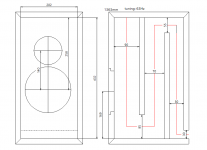 Faital TL.png21 KB · Views: 696
Faital TL.png21 KB · Views: 696 -
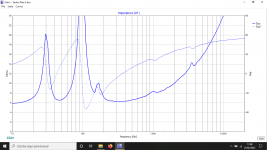 Woofer Z in box.png71.8 KB · Views: 667
Woofer Z in box.png71.8 KB · Views: 667 -
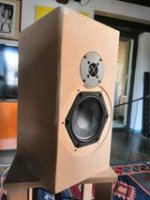 130826312_209868204108922_5458022912079876372_o.jpg8.3 KB · Views: 1,006
130826312_209868204108922_5458022912079876372_o.jpg8.3 KB · Views: 1,006 -
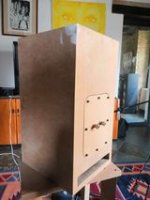 130867735_209868800775529_2967649852867733742_o.jpg8.1 KB · Views: 684
130867735_209868800775529_2967649852867733742_o.jpg8.1 KB · Views: 684 -
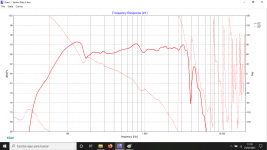 Woofer 30 deg. in box response.png79.1 KB · Views: 664
Woofer 30 deg. in box response.png79.1 KB · Views: 664 -
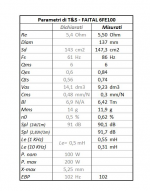 Param.png152.5 KB · Views: 575
Param.png152.5 KB · Views: 575
Last edited:
That is very true! 🙂
The way it is now you could just build a plug for the opening, use them sealed for everyday and remove the plug for party time with extra kick!
The way it is now you could just build a plug for the opening, use them sealed for everyday and remove the plug for party time with extra kick!
Wonderful idea! Nevertheless, even if it is somewhat flawed, it can be a platform to learn why the slipped tuning, to avoid the error in another project, perhaps with a more fitting driver.
Last edited:
None, just rules of tumb. High QT: tune 10 Hz lower than Fs, Offset 1/5 the lenght, reasonable total volume, reasonable line c/s, and so on.
Fortunately the 6FE100 can eat gobs of watts w/o bottoming.
Fortunately the 6FE100 can eat gobs of watts w/o bottoming.
Last edited:
I see, I should have kept the tuning at Fs and the aperture somewhat larger. Thanks for the sim.
Last edited:
I'll try to reverse engineering the object allready built using SpicyTL, and see what comes out, even if It will take a while until I learn ho to correctly use that software.
Hi there!
A question, why I ended up with a 43Hz tuning instead of 63Hz as calculated?
Line not filled but lined with 1" thick noise reduction felt
Can I see the schematic of the crossover?
A bit late to the thread, but since it hasn't been mentioned, your TL tuned lower than its length suggests because it tapers down and has a restricted terminus. The opposite holds; an expanding line will tune higher than the linear QW frequency, unless its terminus is restricted.
What did you end-up doing to these speakers?
I'm not alone then, to have measured the 6FE100 with differing parameters versus the spec sheet. Here's one of my pair below, the other being similar enough.
Thiele-Small parameters
fs 90.3 Hz
Qms 8.039
Qes 1.000
Qts 0.889
Fts 101.5
Mms 12.92 g
Cms 0.241 mm/N
Rms 0.911 kg/s
Vas 6.98 litres
Bl 6.329 Tm
Eta 0.50 %
Lp (1W/1m) 89.15 dB
Dd 13.49 cm
Sd 142.9 cm^2
Cms is half what the spec sheet states (0.48 mm/N). You are right in saying they can take a lot of power though. 🙂
My pair sits in a single 21L sealed enclosure (monophonic) in my garage/shop. With stuffing, Qtc is a bit above 1.0 and it sounds pretty decent. IMO, a slightly longer TL with a fair bit of lining and stuffing might be good for them.
What did you end-up doing to these speakers?
I'm not alone then, to have measured the 6FE100 with differing parameters versus the spec sheet. Here's one of my pair below, the other being similar enough.
Thiele-Small parameters
fs 90.3 Hz
Qms 8.039
Qes 1.000
Qts 0.889
Fts 101.5
Mms 12.92 g
Cms 0.241 mm/N
Rms 0.911 kg/s
Vas 6.98 litres
Bl 6.329 Tm
Eta 0.50 %
Lp (1W/1m) 89.15 dB
Dd 13.49 cm
Sd 142.9 cm^2
Cms is half what the spec sheet states (0.48 mm/N). You are right in saying they can take a lot of power though. 🙂
My pair sits in a single 21L sealed enclosure (monophonic) in my garage/shop. With stuffing, Qtc is a bit above 1.0 and it sounds pretty decent. IMO, a slightly longer TL with a fair bit of lining and stuffing might be good for them.
Hi, I'm using them: Dell laptop Topping DX3 DAC Proton AM2 amp, with a moderate eq down the 150Hz zone exces. I use measured specs, not the factory advertised, see attachment.A bit late to the thread, but since it hasn't been mentioned, your TL tuned lower than its length suggests because it tapers down and has a restricted terminus. The opposite holds; an expanding line will tune higher than the linear QW frequency, unless its terminus is restricted.
What did you end-up doing to these speakers?
I'm not alone then, to have measured the 6FE100 with differing parameters versus the spec sheet. Here's one of my pair below, the other being similar enough.
sure thing: Just R3 is after C3 in the actual buildCan I see the schematic of the crossover?
Attachments
Yes, tapered TL tuning is lower than based on length alone, but is the tapered TL is best for nice tight bass. You can adjust stuffing to bring peaks down and this will reduce group delay. Too much and it sounds dead. The impedance sweep is the way to check though. 45Hz is a nice spot if you can deal with the baffle step loss. You will have to drop system efficiency quite a bit to match the treble with the bass.
FYI/FWIW, IME and proved to my satisfaction when 'proofing' MJK's MathCad design programs against some of my own Tower/Column alignments from 'way back when', the vented TL [closed pipe] alignment [aka MLTL] range from ~0.312 - 0.624 Qts' seems technically good enough, i.e. from Keele's 6th order assisted bass reflex to his Extended Bass Shelf [EBS] alignment.
While the 'sweet spot' [mean] is a ~0.4412 Qts', a 'close enough' simple guideline is:
~0.403, Vb = Vas, Fb = Fs [MLTL]
< ~0.403, Vb = < Vas, Fb = > Fs [inverse tapered MLTQWT]
~0.403, Vb = > Vas, Fb = < Fs [expanding taper MLTQWT/MLhorn]
Qts' = Qts + any added series resistance [Rs]: http://www.mh-audio.nl/Calculators/newqts.html
While the 'sweet spot' [mean] is a ~0.4412 Qts', a 'close enough' simple guideline is:
~0.403, Vb = Vas, Fb = Fs [MLTL]
< ~0.403, Vb = < Vas, Fb = > Fs [inverse tapered MLTQWT]
~0.403, Vb = > Vas, Fb = < Fs [expanding taper MLTQWT/MLhorn]
Qts' = Qts + any added series resistance [Rs]: http://www.mh-audio.nl/Calculators/newqts.html
Thanks!FYI/FWIW, IME and proved to my satisfaction when 'proofing' MJK's MathCad design programs against some of my own Tower/Column alignments from 'way back when', the vented TL [closed pipe] alignment [aka MLTL] range from ~0.312 - 0.624 Qts' seems technically good enough, i.e. from Keele's 6th order assisted bass reflex to his Extended Bass Shelf [EBS] alignment.
While the 'sweet spot' [mean] is a ~0.4412 Qts', a 'close enough' simple guideline is:
~0.403, Vb = Vas, Fb = Fs [MLTL]
< ~0.403, Vb = < Vas, Fb = > Fs [inverse tapered MLTQWT]
~0.403, Vb = > Vas, Fb = < Fs [expanding taper MLTQWT/MLhorn]
Qts' = Qts + any added series resistance [Rs]: http://www.mh-audio.nl/Calculators/newqts.html
I know, but I do prefer to preserve the 90 /88 dB level and eq down the 150 Hz excess via signal modification. Any other eq is embedded in the filter, that deviates from the textbook Butterworth 2nd and 3th order for this very reason.Yes, tapered TL tuning is lower than based on length alone, but is the tapered TL is best for nice tight bass. You can adjust stuffing to bring peaks down and this will reduce group delay. Too much and it sounds dead. The impedance sweep is the way to check though. 45Hz is a nice spot if you can deal with the baffle step loss. You will have to drop system efficiency quite a bit to match the treble with the bass.
- Home
- Loudspeakers
- Multi-Way
- Faital 6FE100 TL
